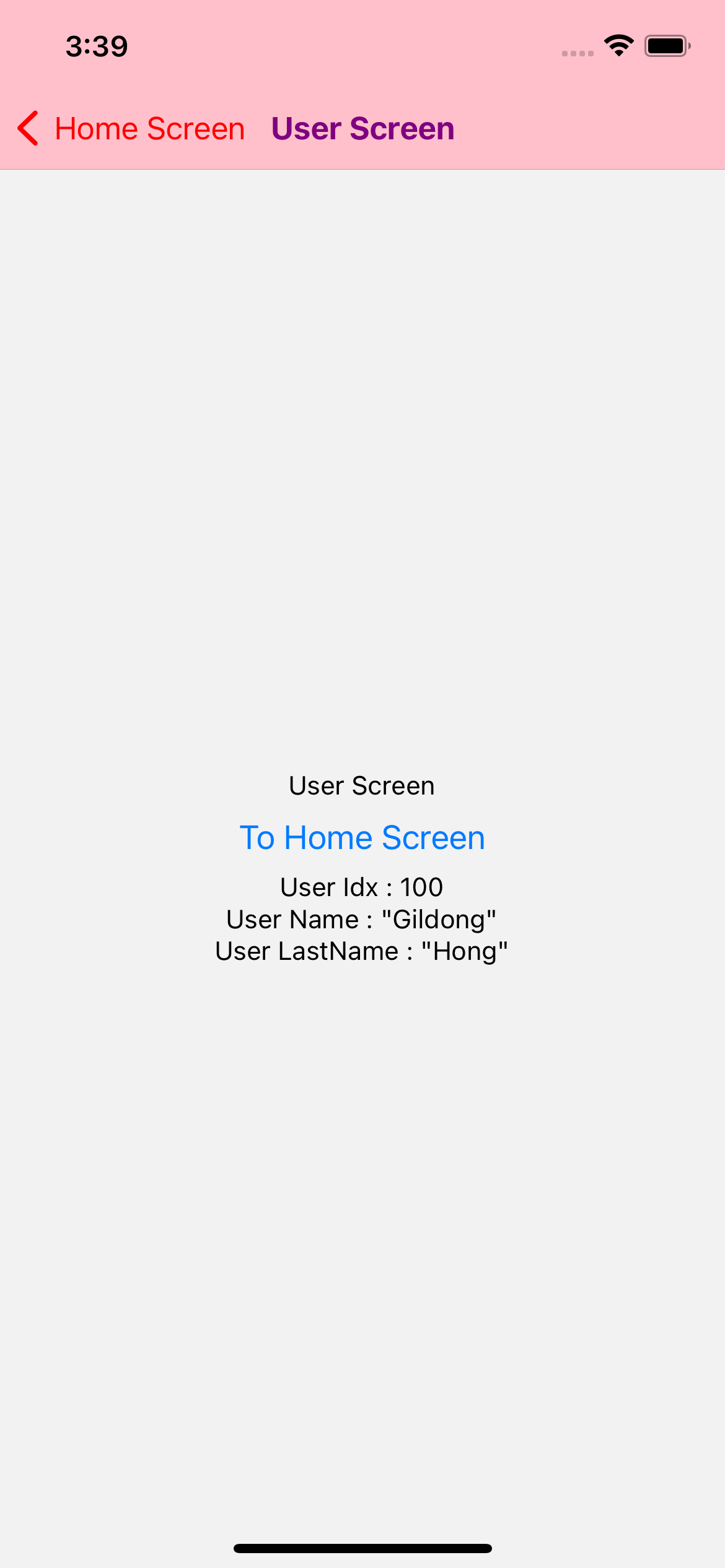2022. 1. 14. 15:47ㆍReact Native/Basic

5. [Stack] Header Bar 설정
헤더바의 이름이나 색상 등을 바꿀 수 있는 방법에 대해 알아보자.
<Stack.Screen
name="Home"
component={HomeScreen}
options={{title: 'Home Screen'}}
/>App.js에서 정의된 스크린에 options라는 프로퍼티를 주고 title이라는 값을 주면 헤더바의 글자를 바꿀 수 있다. 이렇게 하면 초기값으로 헤더 타이틀을 지정할 수 있지만, 그 후에도 임의로 조정 가능하다.
아래 코드처럼 this.props.navigation.setOptions를 통해 헤더바의 설정을 바꿀 수 있다. 글자 뿐 아니라 글자색과 배경색을 바꿀 수도 있다.
<Button
title="Change the title"
onPress={() => {
this.props.navigation.setOptions({
title: 'Changed!!!',
headerStyle: {
backgroundColor: 'pink',
},
headerTintColor: 'red',
});
}}
/>이런 옵션 설정은 초기화로도 사용할 수 있다.
<Stack.Screen
name="User"
component={UserScreen}
initialParams={{
userIdx: 50,
userName: 'Gildong',
userLastName: 'Go',
}}
options={{
title: 'User Screen',
headerStyle: {
backgroundColor: 'pink',
},
headerTintColor: 'red',
headerTitleStyle: {
fontWeight: 'bold',
color: 'purple',
},
}}
/>headerTitleStyle 객체에 fontWeight와 color를 통해 헤더 타이틀의 글자 굵기와 색을 지정할 수도 있다.
그런데 여기서 한 가지 질문이 생기는데 그럼 headerTitleStyle에 정의된 color와 headerTintColor 간의 차이는 뭘까?
아래 코드 실행 결과 화면을 보면 알 수 있다.
이전 화면으로 돌아가기 위해 만들어진 버튼의 색이 headerTintColor, 헤더 타이틀 글자색이 headerTitleStyle에 정의된 color다.

만약 Stack Screen 이 너무 많고 App.js에서 모든 화면에 대한 옵션 설정을 하는 게 너무 길고 장황하면 각 스크린을 구성하는 js 파일에서 설정할 수도 있다. headerStyle이라는 함수를 스크린 안에서 정의하고 this.headerStyle(); 을 써주면 된다.
class UserScreen extends Component {
headerStyle = () => {
this.props.navigation.setOptions({
title: 'Customizing',
headerStyle: {
backgroundColor: 'blue',
},
headerTintColor: 'yellow',
headerTitleStyle: {
fontWeight: 'bold',
color: 'green',
},
});
};
render() {
this.headerStyle();
/*
... 코드 생략 ...
*/
}
}
그런데 헤더 스타일을 모든 화면에서 동일하게 가져가고 싶다면 이런 방식은 비효율적이다. 다음 글은 이 방법에 대해 다룬다.
home.js
/**
* Sample React Native App
* https://github.com/facebook/react-native
*
* @format
* @flow strict-local
*/
import React, {Component} from 'react';
import {StyleSheet, Text, View, Button} from 'react-native';
import {NavigationContainer} from '@react-navigation/native';
import {createNativeStackNavigator} from '@react-navigation/native-stack';
class HomeScreen extends Component {
render() {
return (
<View
style={{
flex: 1,
alignItems: 'center',
justifyContent: 'center',
}}>
<Text>Home Screen</Text>
<Button
title="To User Screen"
onPress={() => {
this.props.navigation.navigate('User', {
userIdx: 100,
userName: 'Gildong',
userLastName: 'Hong',
});
}}
/>
<Button
title="Change the title"
onPress={() => {
this.props.navigation.setOptions({
title: 'Changed!!!',
headerStyle: {
backgroundColor: 'pink',
},
headerTintColor: 'red',
});
}}></Button>
</View>
);
}
}
const styles = StyleSheet.create({});
export default HomeScreen;user.js
/**
* Sample React Native App
* https://github.com/facebook/react-native
*
* @format
* @flow strict-local
*/
import React, {Component} from 'react';
import {StyleSheet, Text, View, Button} from 'react-native';
import {NavigationContainer} from '@react-navigation/native';
import {createNativeStackNavigator} from '@react-navigation/native-stack';
class UserScreen extends Component {
headerStyle = () => {
this.props.navigation.setOptions({
title: 'Customizing',
headerStyle: {
backgroundColor: 'blue',
},
headerTintColor: 'yellow',
headerTitleStyle: {
fontWeight: 'bold',
color: 'green',
},
});
};
render() {
this.headerStyle();
const {params} = this.props.route;
const userIdx = params ? params.userIdx : null;
const userName = params ? params.userName : null;
const userLastName = params ? params.userLastName : null;
return (
<View
style={{
flex: 1,
alignItems: 'center',
justifyContent: 'center',
}}>
<Text>User Screen</Text>
<Button
title="To Home Screen"
onPress={() => {
this.props.navigation.navigate('Home');
}}
/>
<Text>User Idx : {JSON.stringify(userIdx)}</Text>
<Text>User Name : {JSON.stringify(userName)}</Text>
<Text>User LastName : {JSON.stringify(userLastName)}</Text>
</View>
);
}
}
const styles = StyleSheet.create({});
export default UserScreen;App.js
/**
* Sample React Native App
* https://github.com/facebook/react-native
*
* @format
* @flow strict-local
*/
import React, {Component} from 'react';
import {StyleSheet, Text, View} from 'react-native';
import {NavigationContainer} from '@react-navigation/native';
import {createNativeStackNavigator} from '@react-navigation/native-stack';
import HomeScreen from './src/home';
import UserScreen from './src/user';
const Stack = createNativeStackNavigator();
class App extends Component {
render() {
return (
<NavigationContainer>
<Stack.Navigator initialRouteName="Home">
<Stack.Screen
name="Home"
component={HomeScreen}
options={{title: 'Home Screen'}}
/>
<Stack.Screen
name="User"
component={UserScreen}
initialParams={{
userIdx: 50,
userName: 'Gildong',
userLastName: 'Go',
}}
// options={{
// title: 'User Screen',
// headerStyle: {
// backgroundColor: 'pink',
// },
// headerTintColor: 'red',
// headerTitleStyle: {
// fontWeight: 'bold',
// color: 'purple',
// },
// }}
/>
</Stack.Navigator>
</NavigationContainer>
);
}
}
const styles = StyleSheet.create({});
export default App;참고 자료
iOS/Android 앱 개발을 위한 실전 React Native - Basic - 인프런 | 강의
Mobile App Front-End 개발을 위한 React Native의 기초 지식 습득을 목표로 하고 있습니다. 진입장벽이 낮은 언어/API의 활용을 통해 비전문가도 쉽게 Native Mobile App을 개발할 수 있도록 제작된 강의입니다
www.inflearn.com
'React Native > Basic' 카테고리의 다른 글
| [React Native] React Navigation - 7. [Stack] Header Bar 커스터마이징 (0) | 2022.01.17 |
|---|---|
| [React Native] React Navigation - 6. [Stack] 여러 화면에 공통 Style 적용 (0) | 2022.01.14 |
| [React Native] React Navigation - 4. [Stack] Navigation Params (0) | 2022.01.14 |
| [React Native] React Navigation - 3. [Stack] 화면 Linking (0) | 2022.01.13 |
| [React Native] React Navigation - 2. React Navigation 설치 (0) | 2022.01.12 |